UMKD6J-15-1: Analyzing Tesco's Success Factors and Marketing Mix
VerifiedAdded on 2023/01/11
|17
|2883
|25
Report
AI Summary
This report examines Tesco, a major UK retail chain, focusing on its critical success factors: leading market position and social integration. It includes a SWOT analysis of these factors, highlighting strengths, weaknesses, opportunities, and threats. The report analyzes Tesco's marketing strategies through a 7Ps analysis, revealing its cost leadership strategy and product differentiation. Recommendations are provided to leverage these success factors for maximum benefit, including product diversification, cost reduction, and strategic store placement. The analysis considers market competition from rivals like Waitrose and Aldi, and emphasizes the importance of adapting to changing consumer preferences and market dynamics. Desklib offers a platform for students to access this and similar solved assignments.
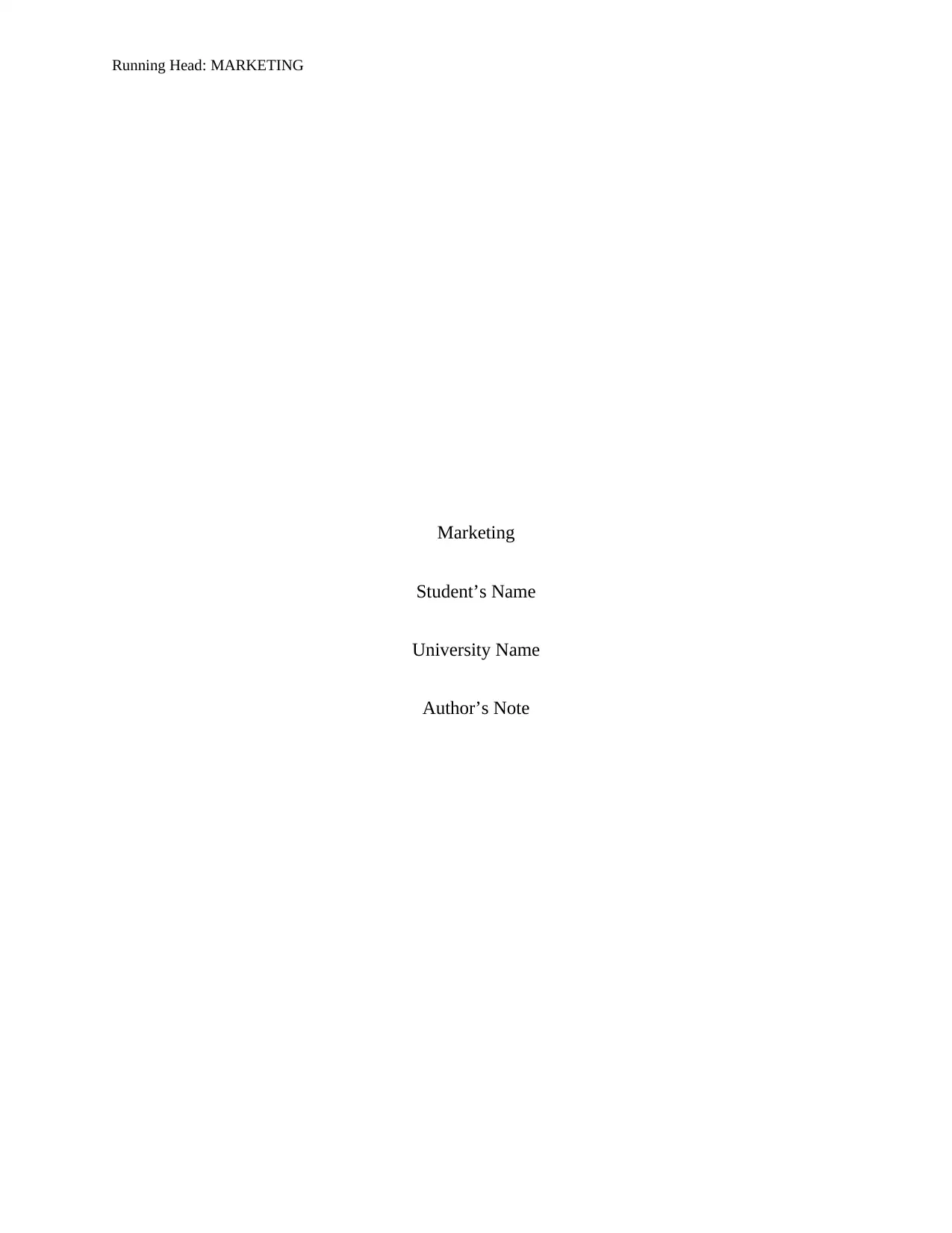
Running Head: MARKETING
Marketing
Student’s Name
University Name
Author’s Note
Marketing
Student’s Name
University Name
Author’s Note
Paraphrase This Document
Need a fresh take? Get an instant paraphrase of this document with our AI Paraphraser
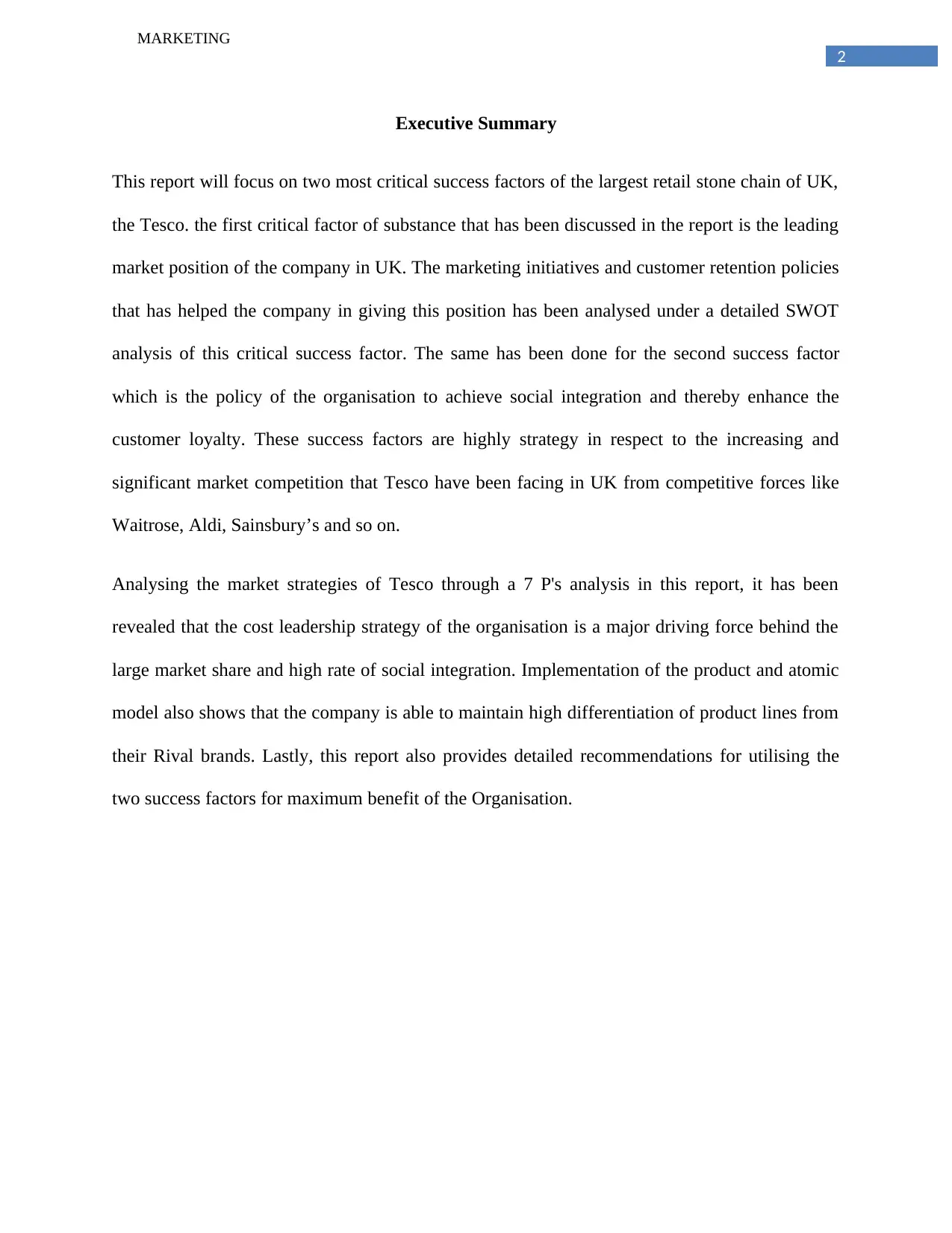
2
MARKETING
Executive Summary
This report will focus on two most critical success factors of the largest retail stone chain of UK,
the Tesco. the first critical factor of substance that has been discussed in the report is the leading
market position of the company in UK. The marketing initiatives and customer retention policies
that has helped the company in giving this position has been analysed under a detailed SWOT
analysis of this critical success factor. The same has been done for the second success factor
which is the policy of the organisation to achieve social integration and thereby enhance the
customer loyalty. These success factors are highly strategy in respect to the increasing and
significant market competition that Tesco have been facing in UK from competitive forces like
Waitrose, Aldi, Sainsbury’s and so on.
Analysing the market strategies of Tesco through a 7 P's analysis in this report, it has been
revealed that the cost leadership strategy of the organisation is a major driving force behind the
large market share and high rate of social integration. Implementation of the product and atomic
model also shows that the company is able to maintain high differentiation of product lines from
their Rival brands. Lastly, this report also provides detailed recommendations for utilising the
two success factors for maximum benefit of the Organisation.
MARKETING
Executive Summary
This report will focus on two most critical success factors of the largest retail stone chain of UK,
the Tesco. the first critical factor of substance that has been discussed in the report is the leading
market position of the company in UK. The marketing initiatives and customer retention policies
that has helped the company in giving this position has been analysed under a detailed SWOT
analysis of this critical success factor. The same has been done for the second success factor
which is the policy of the organisation to achieve social integration and thereby enhance the
customer loyalty. These success factors are highly strategy in respect to the increasing and
significant market competition that Tesco have been facing in UK from competitive forces like
Waitrose, Aldi, Sainsbury’s and so on.
Analysing the market strategies of Tesco through a 7 P's analysis in this report, it has been
revealed that the cost leadership strategy of the organisation is a major driving force behind the
large market share and high rate of social integration. Implementation of the product and atomic
model also shows that the company is able to maintain high differentiation of product lines from
their Rival brands. Lastly, this report also provides detailed recommendations for utilising the
two success factors for maximum benefit of the Organisation.
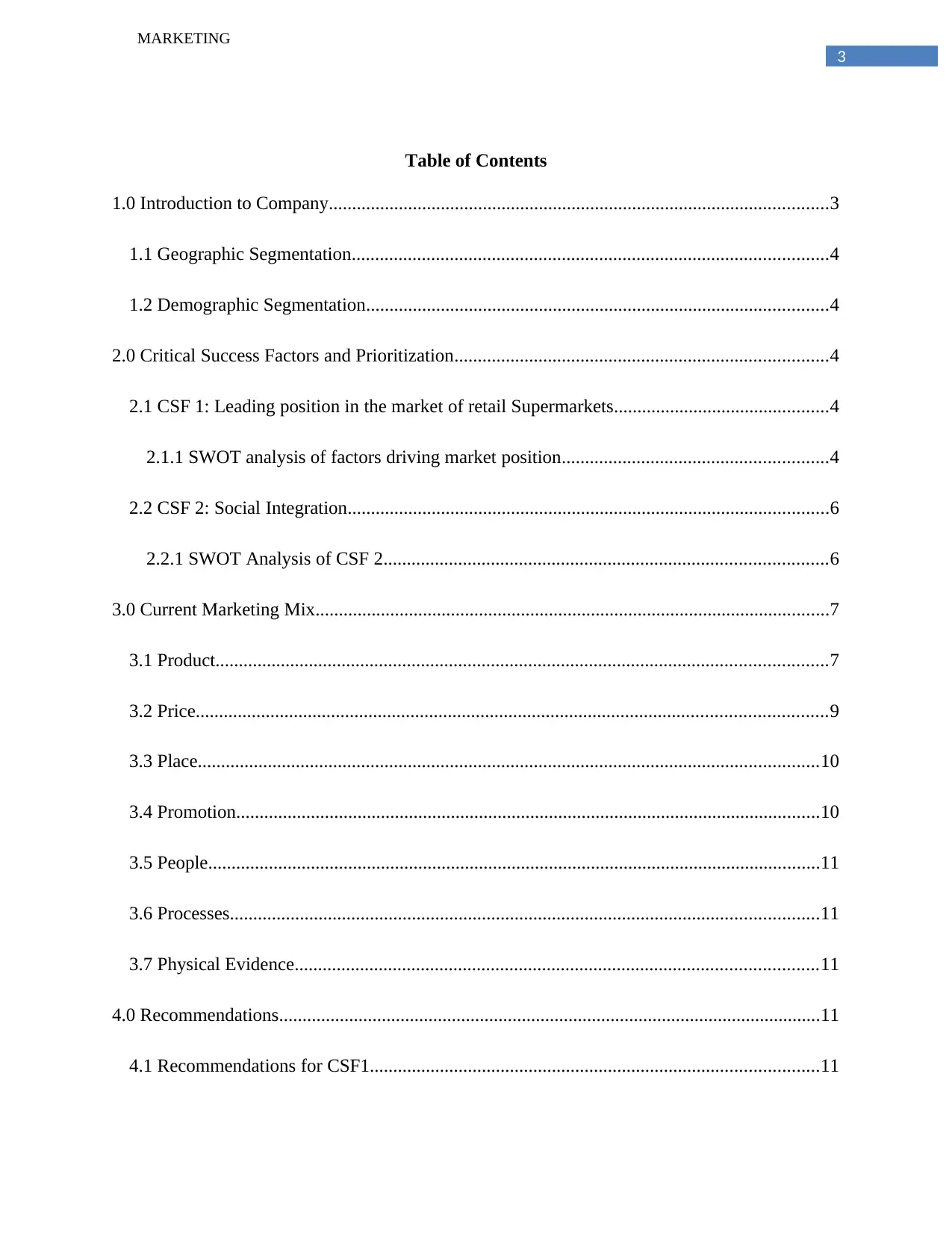
3
MARKETING
Table of Contents
1.0 Introduction to Company...........................................................................................................3
1.1 Geographic Segmentation......................................................................................................4
1.2 Demographic Segmentation...................................................................................................4
2.0 Critical Success Factors and Prioritization................................................................................4
2.1 CSF 1: Leading position in the market of retail Supermarkets..............................................4
2.1.1 SWOT analysis of factors driving market position.........................................................4
2.2 CSF 2: Social Integration.......................................................................................................6
2.2.1 SWOT Analysis of CSF 2...............................................................................................6
3.0 Current Marketing Mix..............................................................................................................7
3.1 Product...................................................................................................................................7
3.2 Price.......................................................................................................................................9
3.3 Place.....................................................................................................................................10
3.4 Promotion.............................................................................................................................10
3.5 People...................................................................................................................................11
3.6 Processes..............................................................................................................................11
3.7 Physical Evidence................................................................................................................11
4.0 Recommendations....................................................................................................................11
4.1 Recommendations for CSF1................................................................................................11
MARKETING
Table of Contents
1.0 Introduction to Company...........................................................................................................3
1.1 Geographic Segmentation......................................................................................................4
1.2 Demographic Segmentation...................................................................................................4
2.0 Critical Success Factors and Prioritization................................................................................4
2.1 CSF 1: Leading position in the market of retail Supermarkets..............................................4
2.1.1 SWOT analysis of factors driving market position.........................................................4
2.2 CSF 2: Social Integration.......................................................................................................6
2.2.1 SWOT Analysis of CSF 2...............................................................................................6
3.0 Current Marketing Mix..............................................................................................................7
3.1 Product...................................................................................................................................7
3.2 Price.......................................................................................................................................9
3.3 Place.....................................................................................................................................10
3.4 Promotion.............................................................................................................................10
3.5 People...................................................................................................................................11
3.6 Processes..............................................................................................................................11
3.7 Physical Evidence................................................................................................................11
4.0 Recommendations....................................................................................................................11
4.1 Recommendations for CSF1................................................................................................11
⊘ This is a preview!⊘
Do you want full access?
Subscribe today to unlock all pages.

Trusted by 1+ million students worldwide
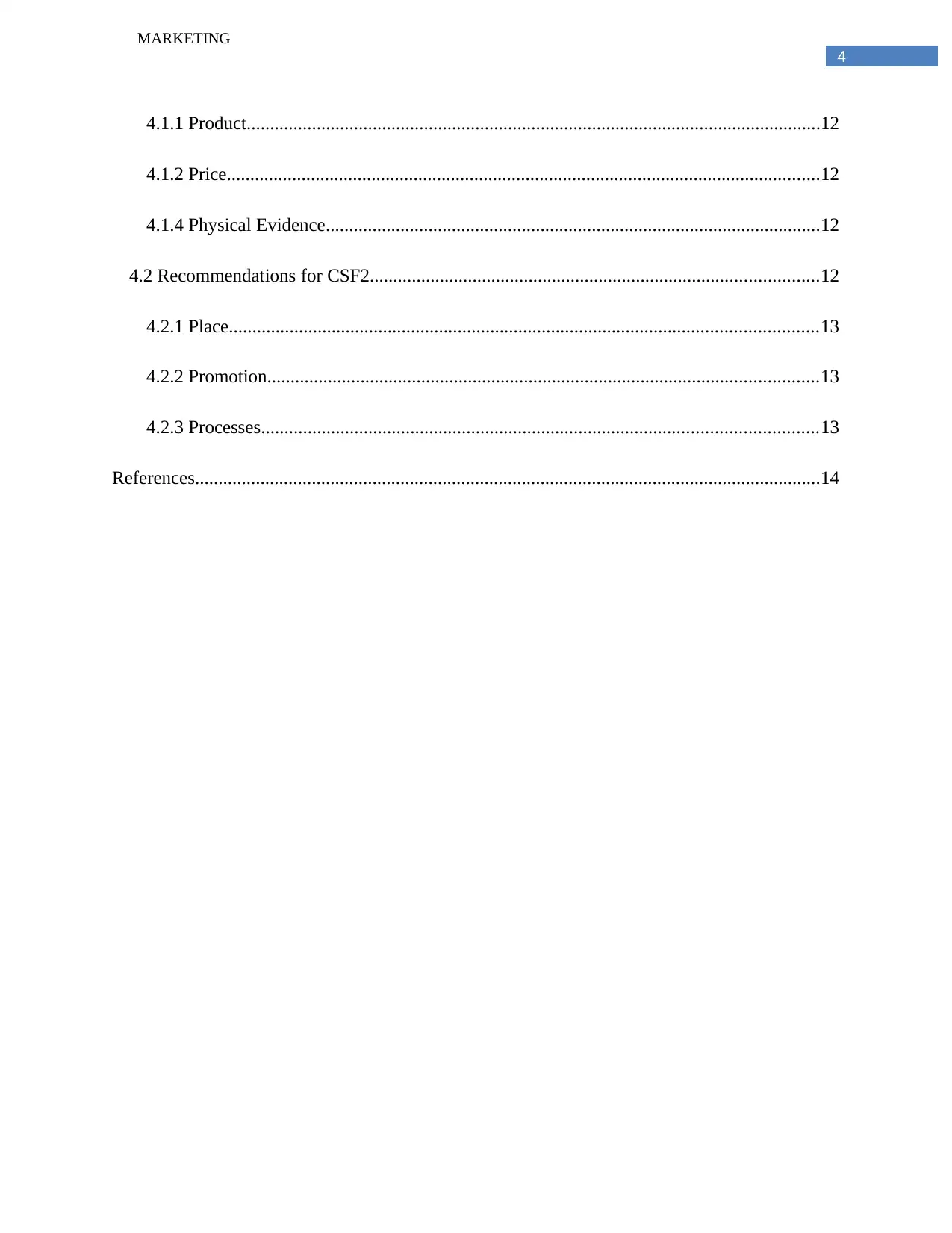
4
MARKETING
4.1.1 Product...........................................................................................................................12
4.1.2 Price...............................................................................................................................12
4.1.4 Physical Evidence..........................................................................................................12
4.2 Recommendations for CSF2................................................................................................12
4.2.1 Place..............................................................................................................................13
4.2.2 Promotion......................................................................................................................13
4.2.3 Processes.......................................................................................................................13
References......................................................................................................................................14
MARKETING
4.1.1 Product...........................................................................................................................12
4.1.2 Price...............................................................................................................................12
4.1.4 Physical Evidence..........................................................................................................12
4.2 Recommendations for CSF2................................................................................................12
4.2.1 Place..............................................................................................................................13
4.2.2 Promotion......................................................................................................................13
4.2.3 Processes.......................................................................................................................13
References......................................................................................................................................14
Paraphrase This Document
Need a fresh take? Get an instant paraphrase of this document with our AI Paraphraser
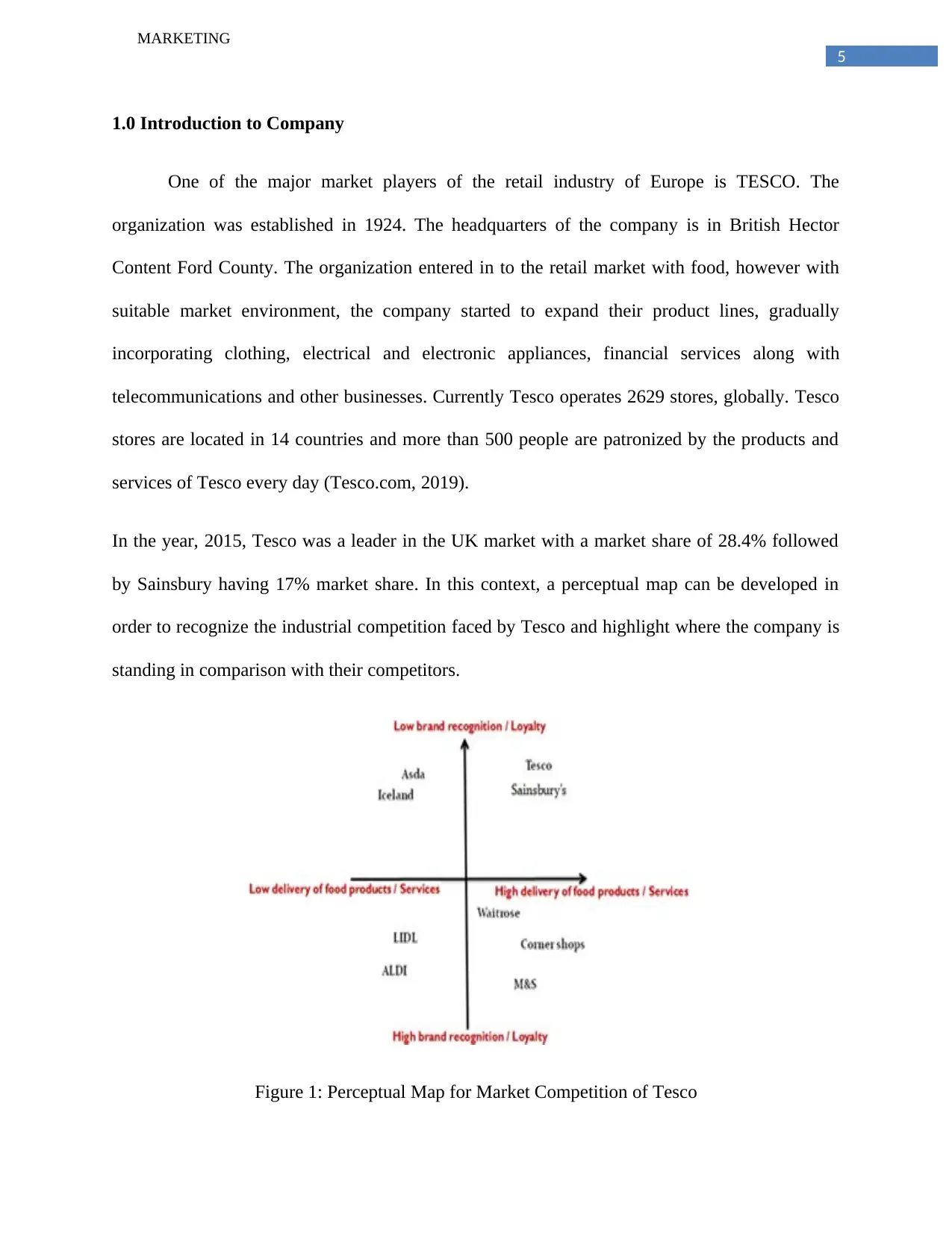
5
MARKETING
1.0 Introduction to Company
One of the major market players of the retail industry of Europe is TESCO. The
organization was established in 1924. The headquarters of the company is in British Hector
Content Ford County. The organization entered in to the retail market with food, however with
suitable market environment, the company started to expand their product lines, gradually
incorporating clothing, electrical and electronic appliances, financial services along with
telecommunications and other businesses. Currently Tesco operates 2629 stores, globally. Tesco
stores are located in 14 countries and more than 500 people are patronized by the products and
services of Tesco every day (Tesco.com, 2019).
In the year, 2015, Tesco was a leader in the UK market with a market share of 28.4% followed
by Sainsbury having 17% market share. In this context, a perceptual map can be developed in
order to recognize the industrial competition faced by Tesco and highlight where the company is
standing in comparison with their competitors.
Figure 1: Perceptual Map for Market Competition of Tesco
MARKETING
1.0 Introduction to Company
One of the major market players of the retail industry of Europe is TESCO. The
organization was established in 1924. The headquarters of the company is in British Hector
Content Ford County. The organization entered in to the retail market with food, however with
suitable market environment, the company started to expand their product lines, gradually
incorporating clothing, electrical and electronic appliances, financial services along with
telecommunications and other businesses. Currently Tesco operates 2629 stores, globally. Tesco
stores are located in 14 countries and more than 500 people are patronized by the products and
services of Tesco every day (Tesco.com, 2019).
In the year, 2015, Tesco was a leader in the UK market with a market share of 28.4% followed
by Sainsbury having 17% market share. In this context, a perceptual map can be developed in
order to recognize the industrial competition faced by Tesco and highlight where the company is
standing in comparison with their competitors.
Figure 1: Perceptual Map for Market Competition of Tesco
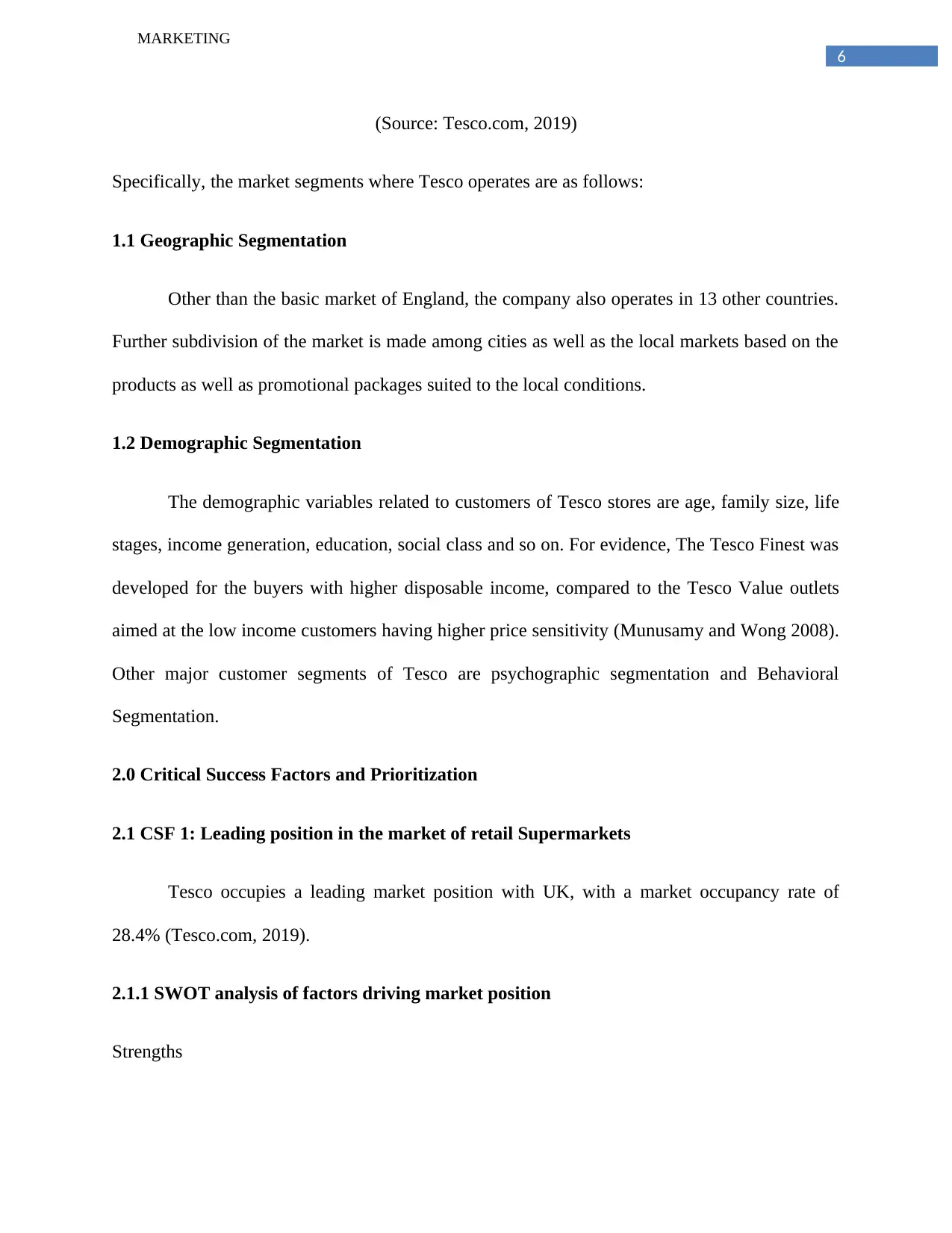
6
MARKETING
(Source: Tesco.com, 2019)
Specifically, the market segments where Tesco operates are as follows:
1.1 Geographic Segmentation
Other than the basic market of England, the company also operates in 13 other countries.
Further subdivision of the market is made among cities as well as the local markets based on the
products as well as promotional packages suited to the local conditions.
1.2 Demographic Segmentation
The demographic variables related to customers of Tesco stores are age, family size, life
stages, income generation, education, social class and so on. For evidence, The Tesco Finest was
developed for the buyers with higher disposable income, compared to the Tesco Value outlets
aimed at the low income customers having higher price sensitivity (Munusamy and Wong 2008).
Other major customer segments of Tesco are psychographic segmentation and Behavioral
Segmentation.
2.0 Critical Success Factors and Prioritization
2.1 CSF 1: Leading position in the market of retail Supermarkets
Tesco occupies a leading market position with UK, with a market occupancy rate of
28.4% (Tesco.com, 2019).
2.1.1 SWOT analysis of factors driving market position
Strengths
MARKETING
(Source: Tesco.com, 2019)
Specifically, the market segments where Tesco operates are as follows:
1.1 Geographic Segmentation
Other than the basic market of England, the company also operates in 13 other countries.
Further subdivision of the market is made among cities as well as the local markets based on the
products as well as promotional packages suited to the local conditions.
1.2 Demographic Segmentation
The demographic variables related to customers of Tesco stores are age, family size, life
stages, income generation, education, social class and so on. For evidence, The Tesco Finest was
developed for the buyers with higher disposable income, compared to the Tesco Value outlets
aimed at the low income customers having higher price sensitivity (Munusamy and Wong 2008).
Other major customer segments of Tesco are psychographic segmentation and Behavioral
Segmentation.
2.0 Critical Success Factors and Prioritization
2.1 CSF 1: Leading position in the market of retail Supermarkets
Tesco occupies a leading market position with UK, with a market occupancy rate of
28.4% (Tesco.com, 2019).
2.1.1 SWOT analysis of factors driving market position
Strengths
⊘ This is a preview!⊘
Do you want full access?
Subscribe today to unlock all pages.

Trusted by 1+ million students worldwide
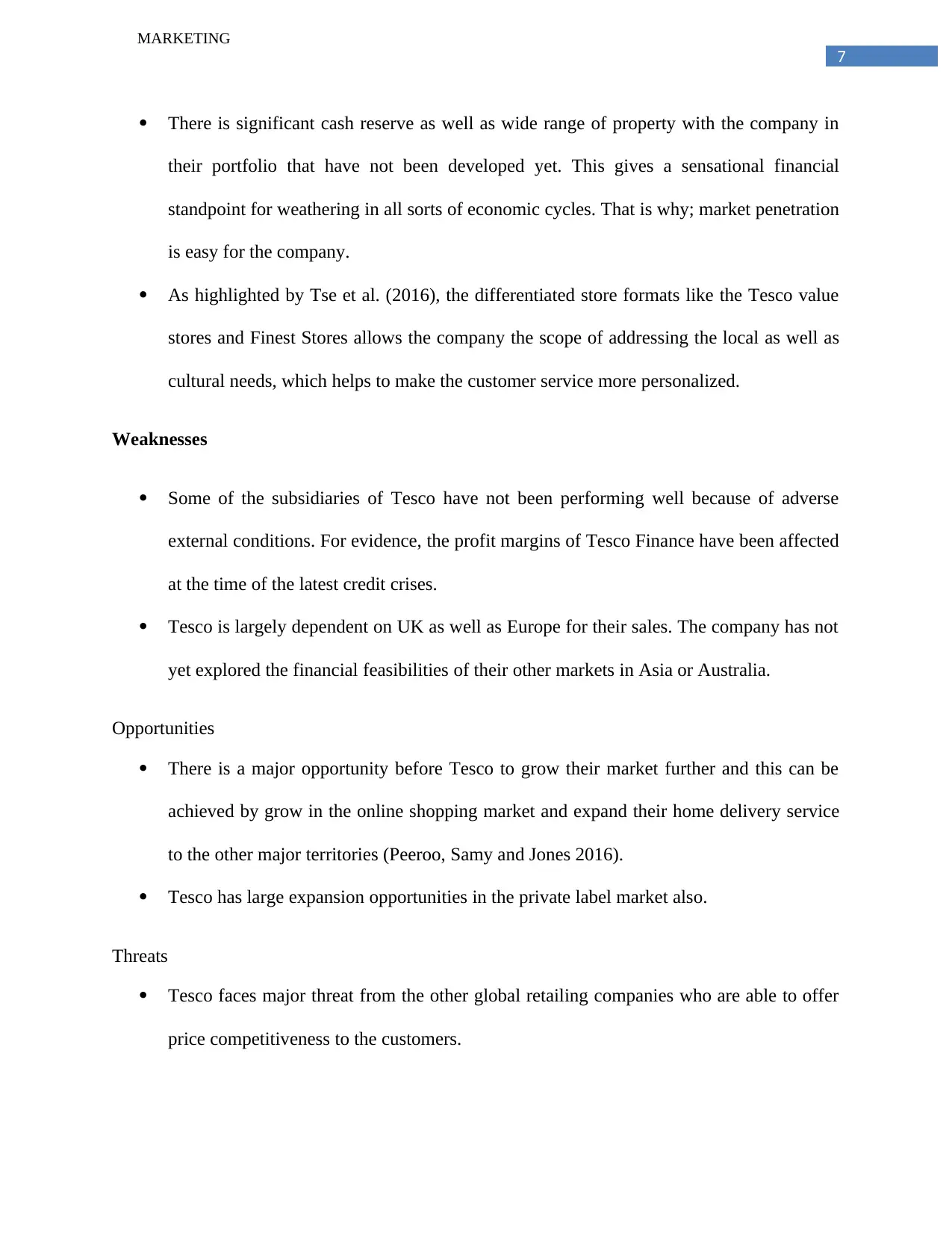
7
MARKETING
There is significant cash reserve as well as wide range of property with the company in
their portfolio that have not been developed yet. This gives a sensational financial
standpoint for weathering in all sorts of economic cycles. That is why; market penetration
is easy for the company.
As highlighted by Tse et al. (2016), the differentiated store formats like the Tesco value
stores and Finest Stores allows the company the scope of addressing the local as well as
cultural needs, which helps to make the customer service more personalized.
Weaknesses
Some of the subsidiaries of Tesco have not been performing well because of adverse
external conditions. For evidence, the profit margins of Tesco Finance have been affected
at the time of the latest credit crises.
Tesco is largely dependent on UK as well as Europe for their sales. The company has not
yet explored the financial feasibilities of their other markets in Asia or Australia.
Opportunities
There is a major opportunity before Tesco to grow their market further and this can be
achieved by grow in the online shopping market and expand their home delivery service
to the other major territories (Peeroo, Samy and Jones 2016).
Tesco has large expansion opportunities in the private label market also.
Threats
Tesco faces major threat from the other global retailing companies who are able to offer
price competitiveness to the customers.
MARKETING
There is significant cash reserve as well as wide range of property with the company in
their portfolio that have not been developed yet. This gives a sensational financial
standpoint for weathering in all sorts of economic cycles. That is why; market penetration
is easy for the company.
As highlighted by Tse et al. (2016), the differentiated store formats like the Tesco value
stores and Finest Stores allows the company the scope of addressing the local as well as
cultural needs, which helps to make the customer service more personalized.
Weaknesses
Some of the subsidiaries of Tesco have not been performing well because of adverse
external conditions. For evidence, the profit margins of Tesco Finance have been affected
at the time of the latest credit crises.
Tesco is largely dependent on UK as well as Europe for their sales. The company has not
yet explored the financial feasibilities of their other markets in Asia or Australia.
Opportunities
There is a major opportunity before Tesco to grow their market further and this can be
achieved by grow in the online shopping market and expand their home delivery service
to the other major territories (Peeroo, Samy and Jones 2016).
Tesco has large expansion opportunities in the private label market also.
Threats
Tesco faces major threat from the other global retailing companies who are able to offer
price competitiveness to the customers.
Paraphrase This Document
Need a fresh take? Get an instant paraphrase of this document with our AI Paraphraser
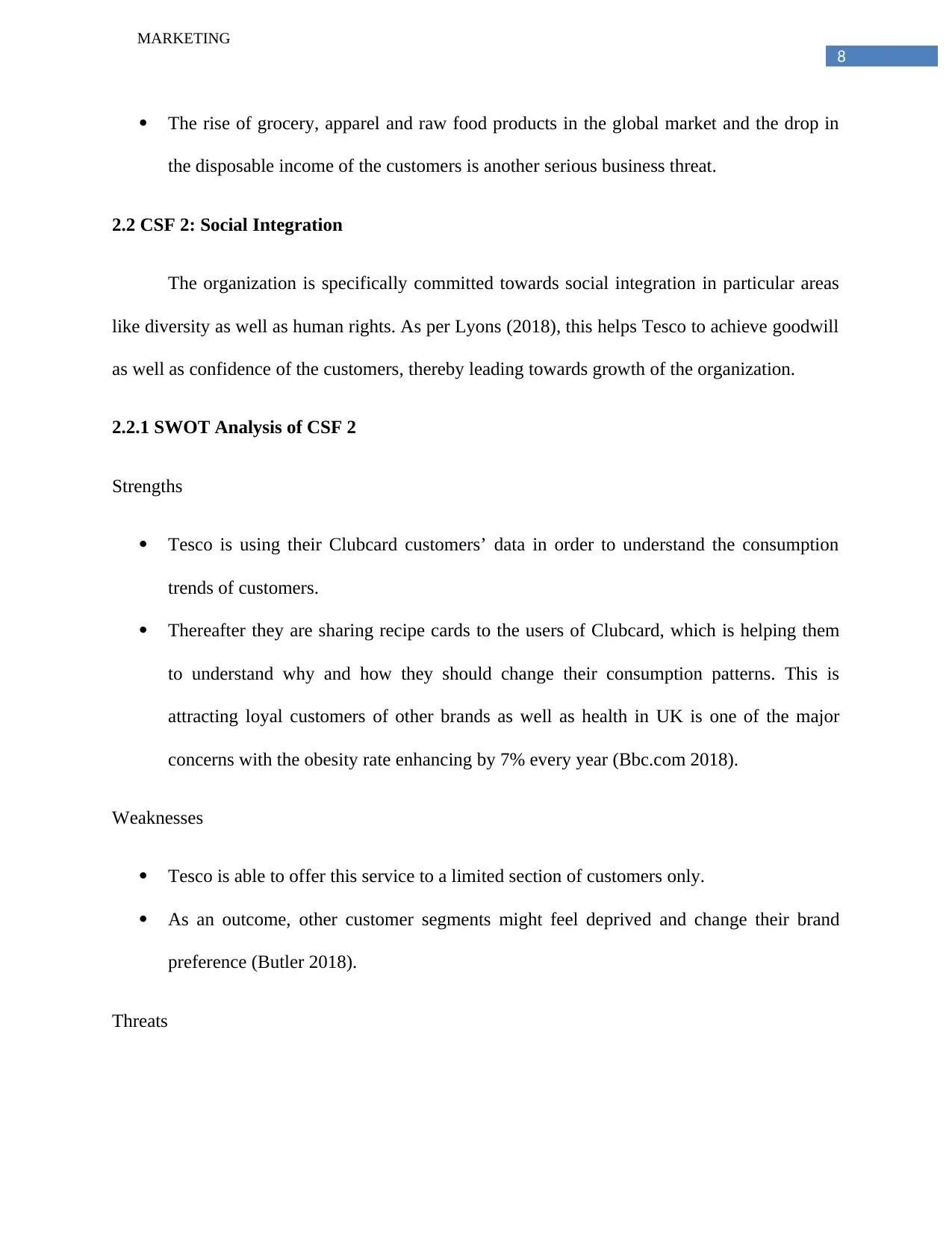
8
MARKETING
The rise of grocery, apparel and raw food products in the global market and the drop in
the disposable income of the customers is another serious business threat.
2.2 CSF 2: Social Integration
The organization is specifically committed towards social integration in particular areas
like diversity as well as human rights. As per Lyons (2018), this helps Tesco to achieve goodwill
as well as confidence of the customers, thereby leading towards growth of the organization.
2.2.1 SWOT Analysis of CSF 2
Strengths
Tesco is using their Clubcard customers’ data in order to understand the consumption
trends of customers.
Thereafter they are sharing recipe cards to the users of Clubcard, which is helping them
to understand why and how they should change their consumption patterns. This is
attracting loyal customers of other brands as well as health in UK is one of the major
concerns with the obesity rate enhancing by 7% every year (Bbc.com 2018).
Weaknesses
Tesco is able to offer this service to a limited section of customers only.
As an outcome, other customer segments might feel deprived and change their brand
preference (Butler 2018).
Threats
MARKETING
The rise of grocery, apparel and raw food products in the global market and the drop in
the disposable income of the customers is another serious business threat.
2.2 CSF 2: Social Integration
The organization is specifically committed towards social integration in particular areas
like diversity as well as human rights. As per Lyons (2018), this helps Tesco to achieve goodwill
as well as confidence of the customers, thereby leading towards growth of the organization.
2.2.1 SWOT Analysis of CSF 2
Strengths
Tesco is using their Clubcard customers’ data in order to understand the consumption
trends of customers.
Thereafter they are sharing recipe cards to the users of Clubcard, which is helping them
to understand why and how they should change their consumption patterns. This is
attracting loyal customers of other brands as well as health in UK is one of the major
concerns with the obesity rate enhancing by 7% every year (Bbc.com 2018).
Weaknesses
Tesco is able to offer this service to a limited section of customers only.
As an outcome, other customer segments might feel deprived and change their brand
preference (Butler 2018).
Threats
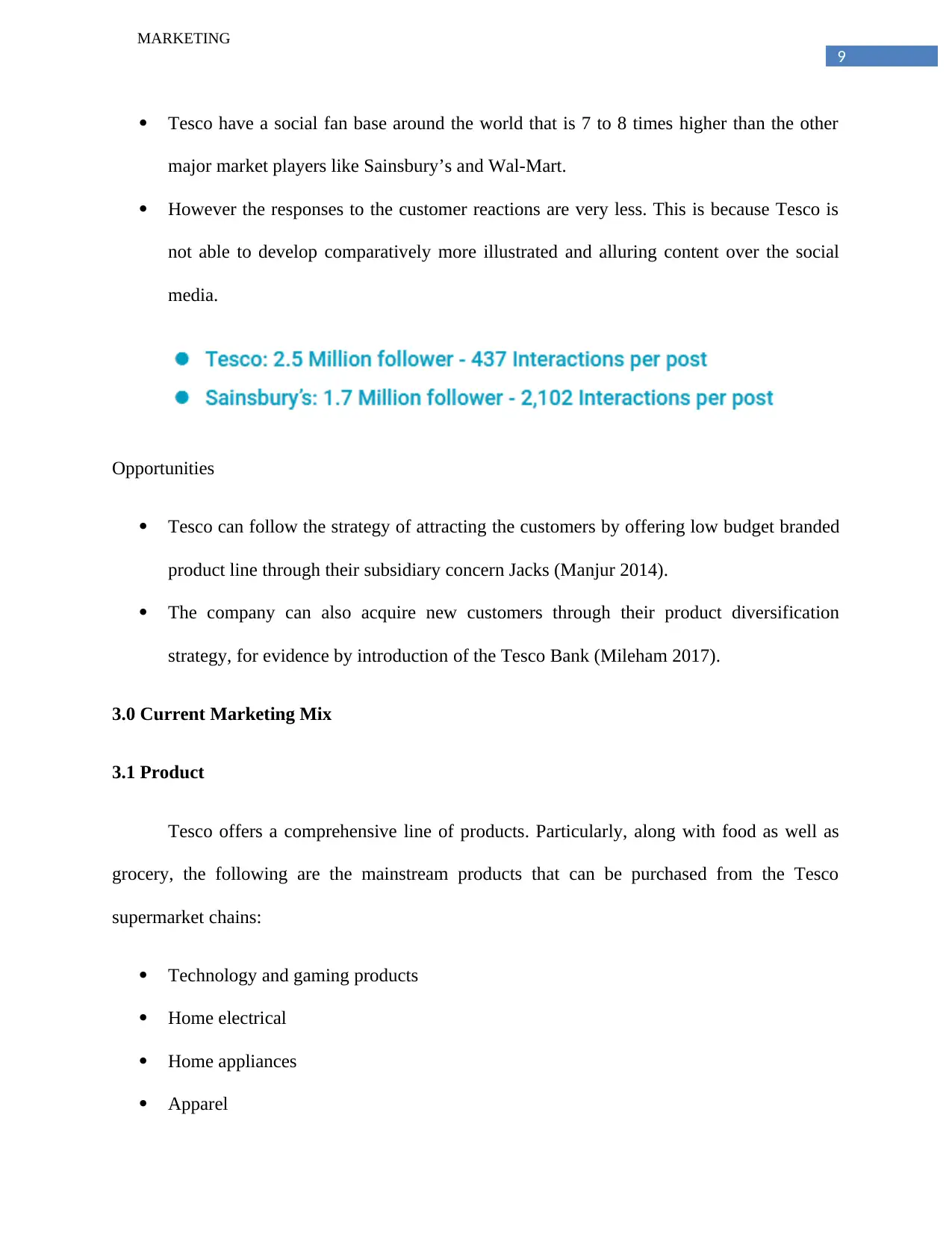
9
MARKETING
Tesco have a social fan base around the world that is 7 to 8 times higher than the other
major market players like Sainsbury’s and Wal-Mart.
However the responses to the customer reactions are very less. This is because Tesco is
not able to develop comparatively more illustrated and alluring content over the social
media.
Opportunities
Tesco can follow the strategy of attracting the customers by offering low budget branded
product line through their subsidiary concern Jacks (Manjur 2014).
The company can also acquire new customers through their product diversification
strategy, for evidence by introduction of the Tesco Bank (Mileham 2017).
3.0 Current Marketing Mix
3.1 Product
Tesco offers a comprehensive line of products. Particularly, along with food as well as
grocery, the following are the mainstream products that can be purchased from the Tesco
supermarket chains:
Technology and gaming products
Home electrical
Home appliances
Apparel
MARKETING
Tesco have a social fan base around the world that is 7 to 8 times higher than the other
major market players like Sainsbury’s and Wal-Mart.
However the responses to the customer reactions are very less. This is because Tesco is
not able to develop comparatively more illustrated and alluring content over the social
media.
Opportunities
Tesco can follow the strategy of attracting the customers by offering low budget branded
product line through their subsidiary concern Jacks (Manjur 2014).
The company can also acquire new customers through their product diversification
strategy, for evidence by introduction of the Tesco Bank (Mileham 2017).
3.0 Current Marketing Mix
3.1 Product
Tesco offers a comprehensive line of products. Particularly, along with food as well as
grocery, the following are the mainstream products that can be purchased from the Tesco
supermarket chains:
Technology and gaming products
Home electrical
Home appliances
Apparel
⊘ This is a preview!⊘
Do you want full access?
Subscribe today to unlock all pages.

Trusted by 1+ million students worldwide
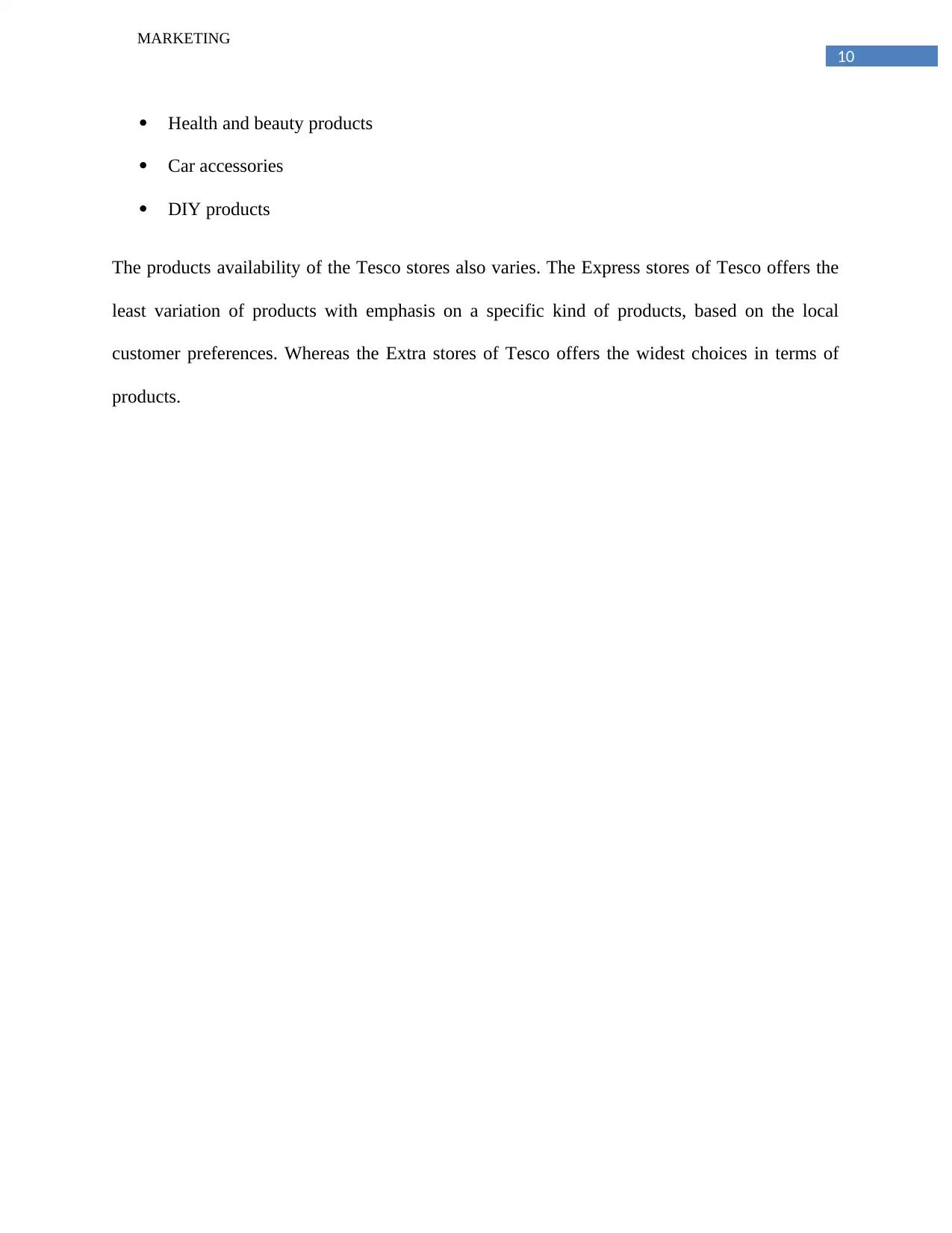
10
MARKETING
Health and beauty products
Car accessories
DIY products
The products availability of the Tesco stores also varies. The Express stores of Tesco offers the
least variation of products with emphasis on a specific kind of products, based on the local
customer preferences. Whereas the Extra stores of Tesco offers the widest choices in terms of
products.
CoreBenefitsLargestrangeofproductsofregularneed.Expressstoresdelierthemostneededproductsinanylocality.GenericProducts:Technologyandgamingproducts,Homeelectrical,Homeappliances,Apparel,Healthandbeautyproducts,Caraccessories,DIYproductsalongwithgrocery
MARKETING
Health and beauty products
Car accessories
DIY products
The products availability of the Tesco stores also varies. The Express stores of Tesco offers the
least variation of products with emphasis on a specific kind of products, based on the local
customer preferences. Whereas the Extra stores of Tesco offers the widest choices in terms of
products.
CoreBenefitsLargestrangeofproductsofregularneed.Expressstoresdelierthemostneededproductsinanylocality.GenericProducts:Technologyandgamingproducts,Homeelectrical,Homeappliances,Apparel,Healthandbeautyproducts,Caraccessories,DIYproductsalongwithgrocery
Paraphrase This Document
Need a fresh take? Get an instant paraphrase of this document with our AI Paraphraser
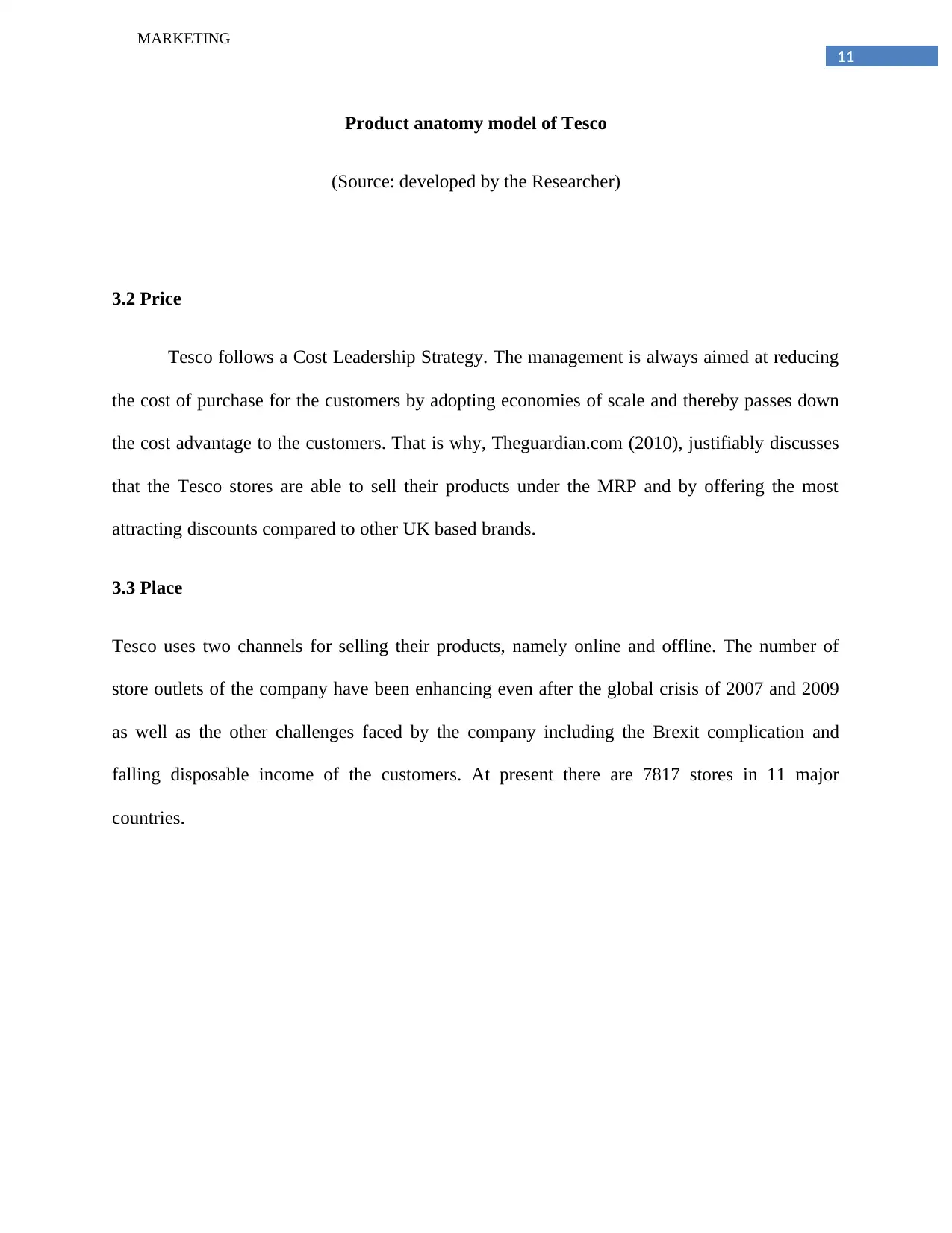
11
MARKETING
Product anatomy model of Tesco
(Source: developed by the Researcher)
3.2 Price
Tesco follows a Cost Leadership Strategy. The management is always aimed at reducing
the cost of purchase for the customers by adopting economies of scale and thereby passes down
the cost advantage to the customers. That is why, Theguardian.com (2010), justifiably discusses
that the Tesco stores are able to sell their products under the MRP and by offering the most
attracting discounts compared to other UK based brands.
3.3 Place
Tesco uses two channels for selling their products, namely online and offline. The number of
store outlets of the company have been enhancing even after the global crisis of 2007 and 2009
as well as the other challenges faced by the company including the Brexit complication and
falling disposable income of the customers. At present there are 7817 stores in 11 major
countries.
MARKETING
Product anatomy model of Tesco
(Source: developed by the Researcher)
3.2 Price
Tesco follows a Cost Leadership Strategy. The management is always aimed at reducing
the cost of purchase for the customers by adopting economies of scale and thereby passes down
the cost advantage to the customers. That is why, Theguardian.com (2010), justifiably discusses
that the Tesco stores are able to sell their products under the MRP and by offering the most
attracting discounts compared to other UK based brands.
3.3 Place
Tesco uses two channels for selling their products, namely online and offline. The number of
store outlets of the company have been enhancing even after the global crisis of 2007 and 2009
as well as the other challenges faced by the company including the Brexit complication and
falling disposable income of the customers. At present there are 7817 stores in 11 major
countries.
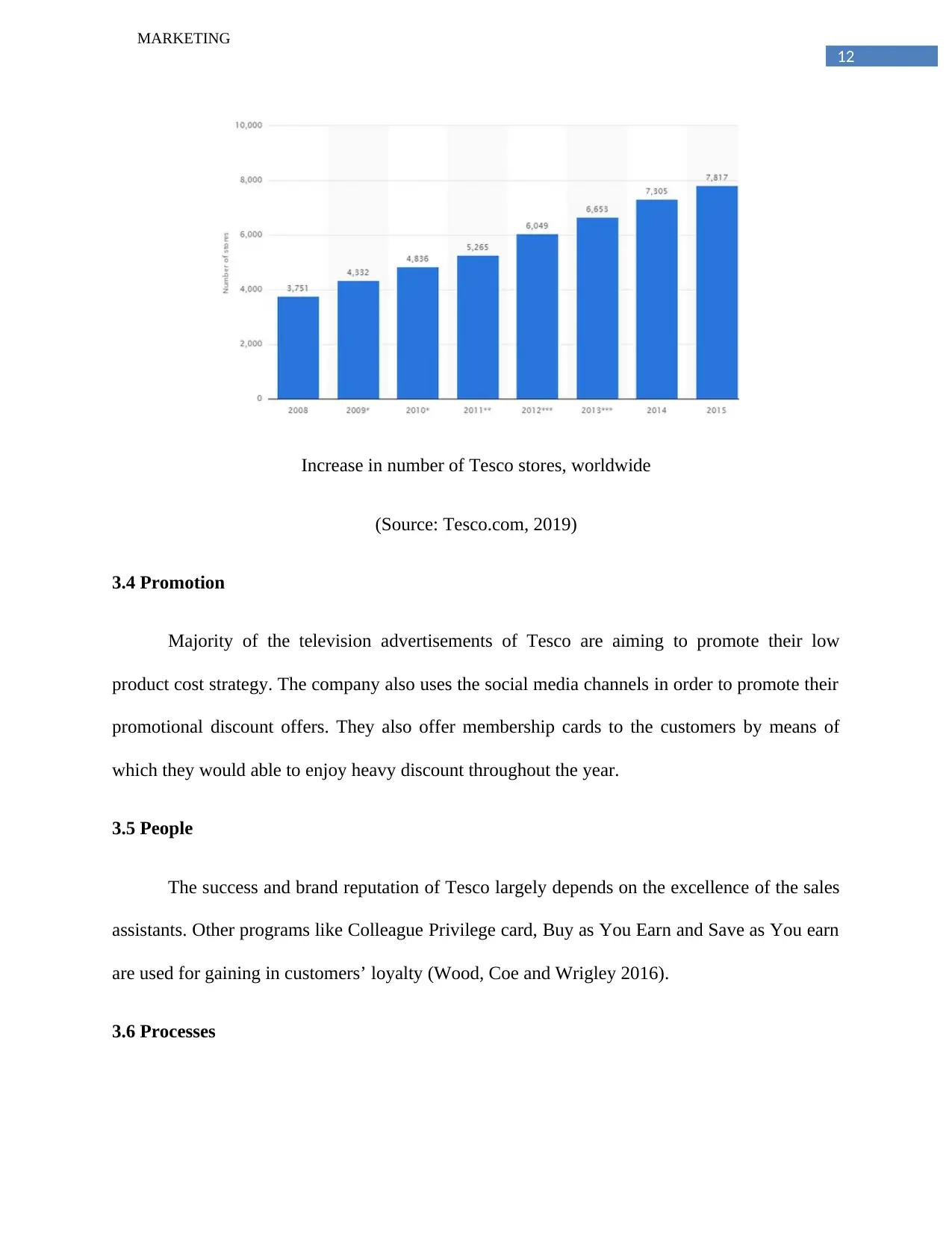
12
MARKETING
Increase in number of Tesco stores, worldwide
(Source: Tesco.com, 2019)
3.4 Promotion
Majority of the television advertisements of Tesco are aiming to promote their low
product cost strategy. The company also uses the social media channels in order to promote their
promotional discount offers. They also offer membership cards to the customers by means of
which they would able to enjoy heavy discount throughout the year.
3.5 People
The success and brand reputation of Tesco largely depends on the excellence of the sales
assistants. Other programs like Colleague Privilege card, Buy as You Earn and Save as You earn
are used for gaining in customers’ loyalty (Wood, Coe and Wrigley 2016).
3.6 Processes
MARKETING
Increase in number of Tesco stores, worldwide
(Source: Tesco.com, 2019)
3.4 Promotion
Majority of the television advertisements of Tesco are aiming to promote their low
product cost strategy. The company also uses the social media channels in order to promote their
promotional discount offers. They also offer membership cards to the customers by means of
which they would able to enjoy heavy discount throughout the year.
3.5 People
The success and brand reputation of Tesco largely depends on the excellence of the sales
assistants. Other programs like Colleague Privilege card, Buy as You Earn and Save as You earn
are used for gaining in customers’ loyalty (Wood, Coe and Wrigley 2016).
3.6 Processes
⊘ This is a preview!⊘
Do you want full access?
Subscribe today to unlock all pages.

Trusted by 1+ million students worldwide
1 out of 17
Related Documents
Your All-in-One AI-Powered Toolkit for Academic Success.
+13062052269
info@desklib.com
Available 24*7 on WhatsApp / Email
![[object Object]](/_next/static/media/star-bottom.7253800d.svg)
Unlock your academic potential
Copyright © 2020–2025 A2Z Services. All Rights Reserved. Developed and managed by ZUCOL.




